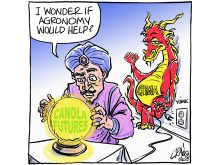Seed growers sent the rest of their trade a message last week — trust for farmers is earned.
A multi-year project to bring five groups involved in the seed growing and development business together under one umbrella entity was shut down at the 11th hour by producers.
The four other groups involved — the Canadian Plant Technology Agency, the Canadian Seed Trade Association, the Commercial Seed Analysts Association of Canada and the Canadian Seed Institute — had previously agreed to the merger through voting of their members.
But the 751 votes counted from the farmers’ group, the Canadian Seed Growers Association, said “no thanks.” The vote didn’t even get a simple majority, let alone the two-thirds needed. Producers in the CSGA voted 337 in favour and 414 against.
Read Also

Surviving a bad harvest day sometimes requires a little luck
Producer and writer Kevin Hursh shares a day of three potentially disastrous incidents as cautionary tales of farm safety for Prairie farmers in the midst of fall harvest work.
During the past couple years, many seed growers suggested the process to merge was moving either too fast or it failed to provide them with a clear picture of what the organization would look like following the deal.
Some said they didn’t feel as though their stake in the final arrangement would be properly recognized in the proposed new organization or that their collective voice, especially when it came to lobbying governments, would be one heard in the corridors of power. Others raised issues relating to international trade, seed development and approval of genetics, suggesting farmers’ interests might be different from their new partners, and they feared their abilities to seek policy changes or actions could become more challenging.
Not all of the responsibilities of the new organization were fully worked out ahead of the vote, say some producers, including their role in paying dues or fees. That appeared to cause some growers to question other areas of the relationship, suggesting “if they can’t tell that, then what else don’t we know.”
Growers also suggested that joint meetings of the organizations failed to address their concerns fully and in some cases they felt as though the rest of the industry was treating the deal as though it was done.
The seed producers’ rejection of the amalgamation effort appears to come down to a trust issue that the past two years of meetings and communications have failed to resolve.
In the past decade or so, governments in Canada have been asking agriculture to speak with fewer voices. They have felt there were too many opinions and too many masters to serve, often with conflicting views of how things should be done.
Part of this followed the collapse of the prairie wheat pools as a farmer-run entity. Those organizations were relied upon for consolidated opinions that politicians could have confidence in. While other farm groups existed, and their positions were also heard and valued, the post-pools era left a big hole in the lobbying department and tied up a lot of politicians and their senior staff with more time needed to listen to agricultural lobbyists.
The needs of government played a role for the seed associations’ push for consolidation, as did the desire for better communications.
Overall, communications from the seed industry to commercial growers will be more effective if it has fewer messages and can focus more on delivery of its messages. It is an important reason for the groups to unite and is in the interests of all five associations.
More time and more answers might give seed growers the information they need to make another decision about combining the associations.
The entire industry, including government, must take note of what happened last week. We can’t take farmers’ support for granted — it’s earned.
Karen Briere, Bruce Dyck, Barb Glen and Mike Raine collaborate in the writing of Western Producer editorials.















